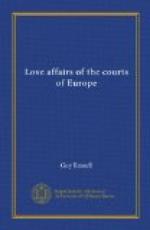THE ROMANCE OF THE BEAUTIFUL SWEDE
Augustus the Strong, Elector of Saxony and King of Poland, owes his place in the world’s memory to his brawny muscles and to his conquest of women. Like the third Alexander of Russia of later years, he could, with his powerful arms, convert a thick iron bar into a necklace, crush a pewter tankard by the pressure of a mighty hand, toss a heavy anvil into the air and catch it as another man would catch a ball, or with a wrench straighten out the stoutest horse-shoe ever forged.
And his strength of muscle was matched by his skill in the lists of love. No Louis of France could boast such an array of conquests as this Saxon Hercules, who changed his mistresses as easily as he changed his coats; the fairest women in Europe, from Turkey to Poland, succeeded each other in bewildering succession as the slaves of his pleasure, and before he died he counted his children to as many as the year has days.
Of all these fair and frail women who thus ministered to the pleasure of the “Saxon Samson,” none was so beautiful, so gifted, so altogether alluring as Marie Aurora, Countess of Koenigsmarck, the younger of the two daughters of Conrad of Koenigsmarck. Born in the year 1668, Aurora was one of three children of the Swedish Count Conrad and his wife, the daughter of the great Field-Marshal Wrangel. Her elder sister, little less fair than herself, found a husband, when little more than a child, in Count Axel Loewenhaupt; her brother Philip, the handsomest man of his day in Europe, was destined to end his days tragically as the price of his infatuation for a Queen.
Betrayed by a jealous woman, the Countess Platen, whose overtures he spurned, this too gallant lover of Sophia Dorothea of Celle, wife of the first of our Georges, was foully done to death in a corridor of the Leine Schloss by La Paten’s hired assassins, while she looked smilingly on at his futile struggle for life, and gloated over his dying agonies.
On the death of her father, when she was but a child of three, Aurora was taken by her mother from her native Sweden to Hamburg, where she grew to beautiful young womanhood; and when, in turn, her mother died, she found a home with her married sister, the Countess Loewenhaupt. And it is at this period of her life that her romantic story opens.
If we are to believe her contemporaries, the world has seldom seen so much beauty and so many graces enshrined in the form of woman as in this daughter of Sweden. Her description reads like a catalogue of all human perfections. Of medium height and a figure as faultless in its exquisite modelling as in its grace and suppleness; her hair, black as a raven’s plumage, and falling, like a veil of night, below her knees, emphasised the white purity of face and throat, arms, and hands. Her teeth, twin rows of pearls, glistened between smiling crimson lips, curved like Cupid’s bow. Her face of perfect oval, with its delicately moulded features, was illuminated by a pair of large black eyes, now melting, now flaming, as mood succeeded mood.




